Thermodynamics 2 - Engine Efficiency and Performance Analysis
VerifiedAdded on 2021/04/16
|11
|905
|49
Homework Assignment
AI Summary
This document presents a detailed solution to a Thermodynamics 2 assignment. The solution covers various aspects of engine analysis, including isentropic processes, the Morse test for multi-cylinder engines, and calculations for indicated power, mechanical efficiency, and break thermal efficiency. The assignment addresses both theoretical concepts and practical applications, providing step-by-step calculations and explanations for each problem. It includes the analysis of engine performance based on given parameters, applying relevant formulas and principles to determine various efficiency metrics. The solution also provides a bibliography of the sources used. This assignment is a comprehensive resource for students studying thermodynamics and internal combustion engines, offering a clear understanding of engine performance analysis and efficiency calculations.
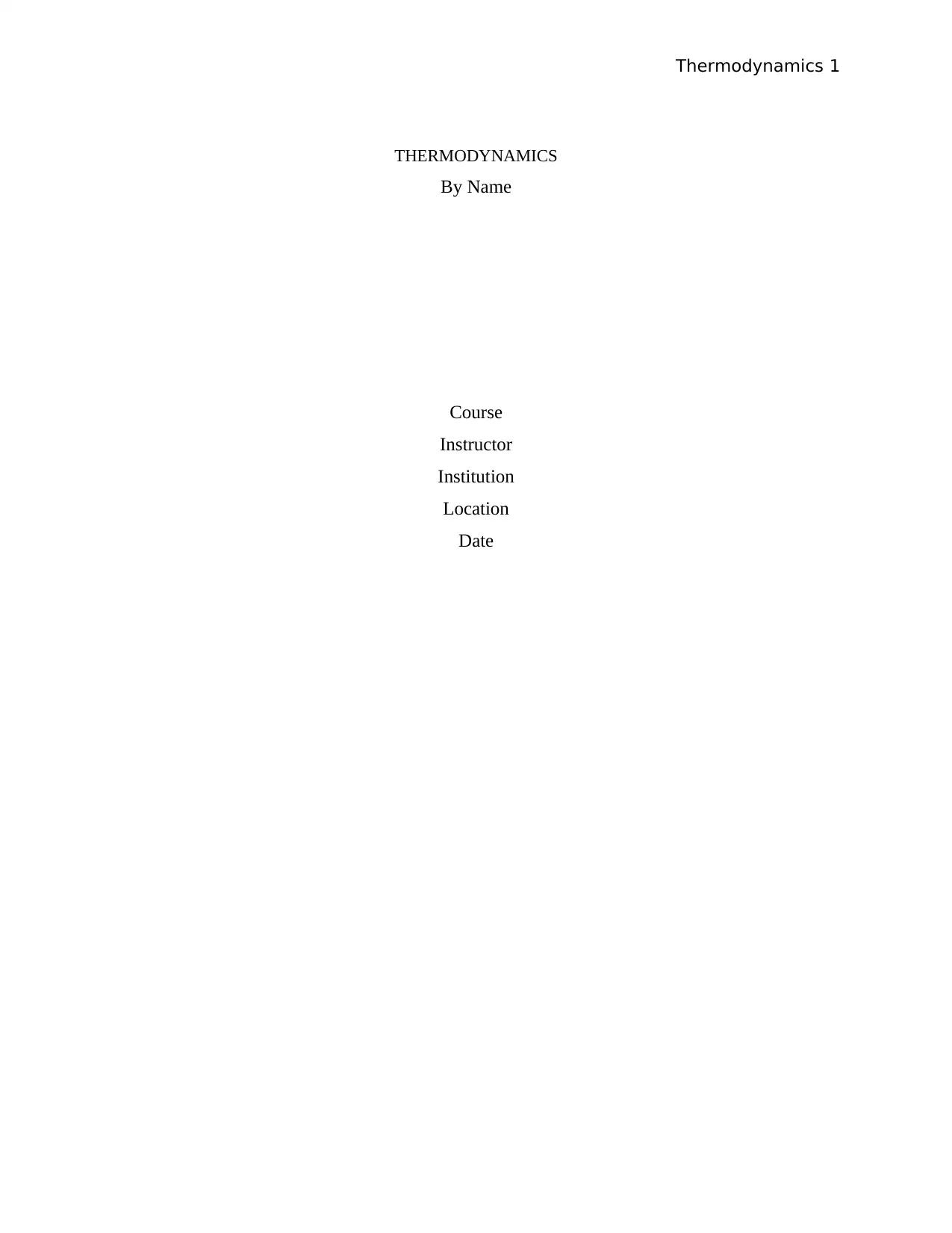
Thermodynamics 1
THERMODYNAMICS
By Name
Course
Instructor
Institution
Location
Date
THERMODYNAMICS
By Name
Course
Instructor
Institution
Location
Date
Paraphrase This Document
Need a fresh take? Get an instant paraphrase of this document with our AI Paraphraser
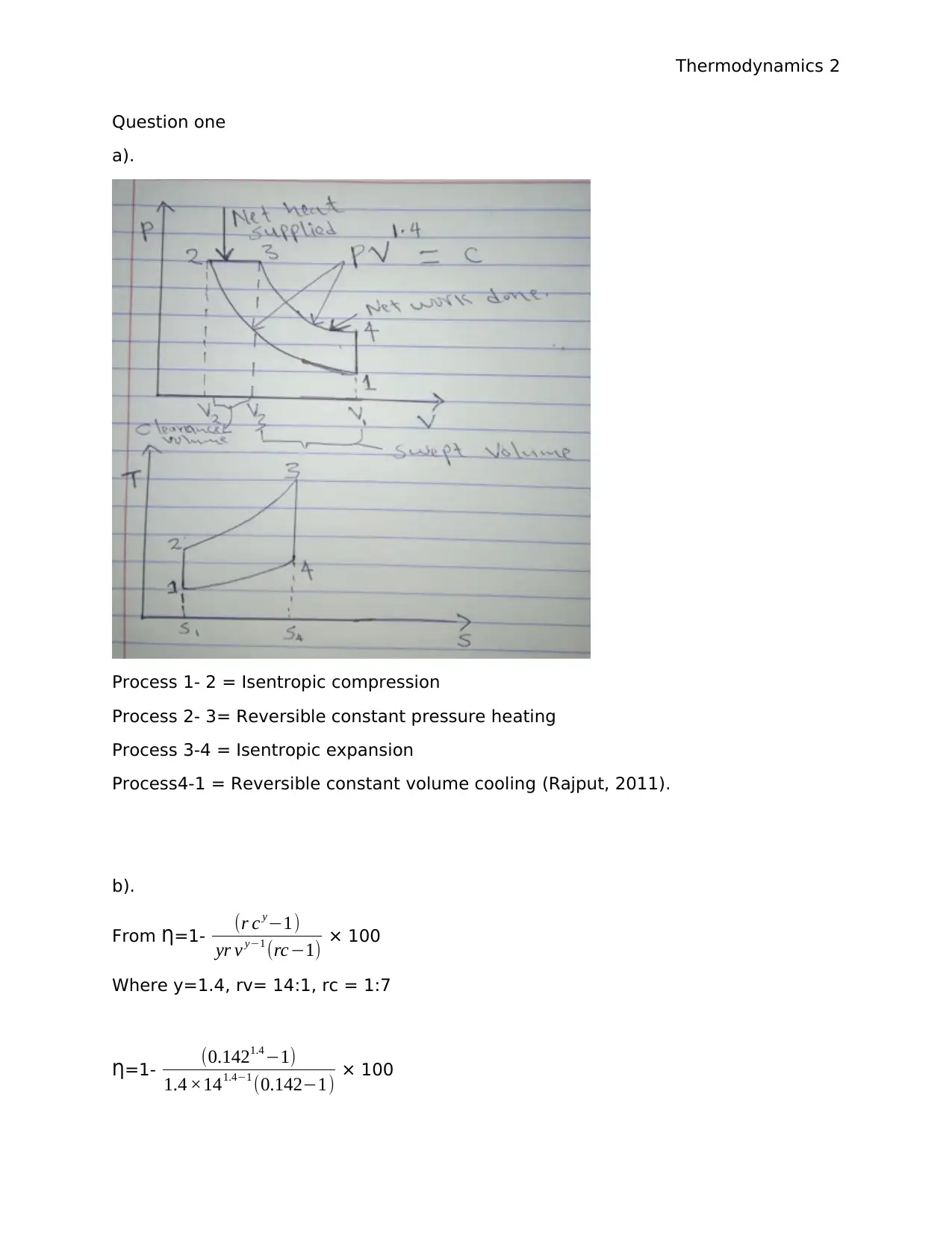
Thermodynamics 2
Question one
a).
Process 1- 2 = Isentropic compression
Process 2- 3= Reversible constant pressure heating
Process 3-4 = Isentropic expansion
Process4-1 = Reversible constant volume cooling (Rajput, 2011).
b).
From Ƞ=1- (r c y−1)
yr v y−1 (rc−1) × 100
Where y=1.4, rv= 14:1, rc = 1:7
Ƞ=1- (0.1421.4 −1)
1.4 ×141.4−1 (0.142−1) × 100
Question one
a).
Process 1- 2 = Isentropic compression
Process 2- 3= Reversible constant pressure heating
Process 3-4 = Isentropic expansion
Process4-1 = Reversible constant volume cooling (Rajput, 2011).
b).
From Ƞ=1- (r c y−1)
yr v y−1 (rc−1) × 100
Where y=1.4, rv= 14:1, rc = 1:7
Ƞ=1- (0.1421.4 −1)
1.4 ×141.4−1 (0.142−1) × 100
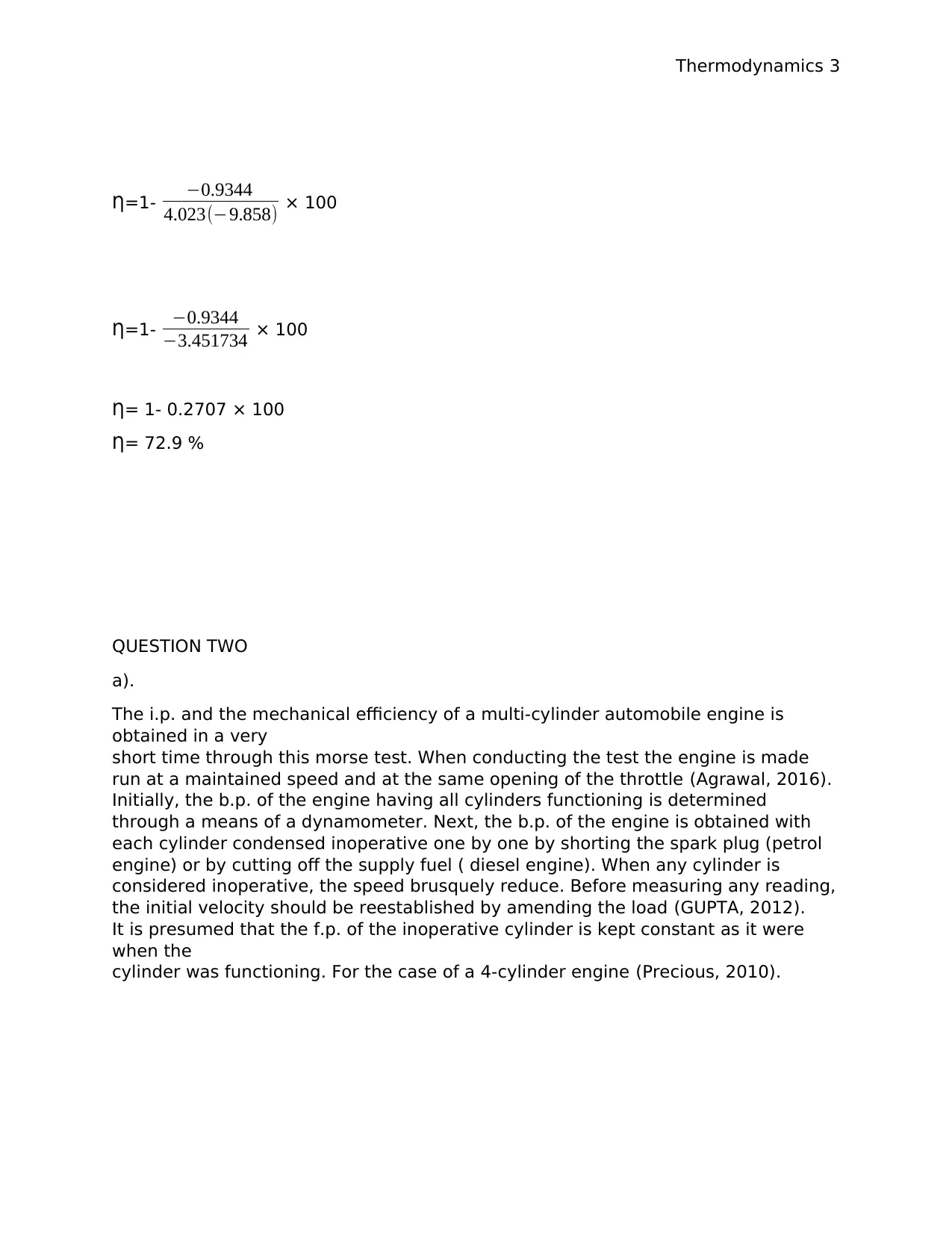
Thermodynamics 3
Ƞ=1- −0.9344
4.023(−9.858) × 100
Ƞ=1- −0.9344
−3.451734 × 100
Ƞ= 1- 0.2707 × 100
Ƞ= 72.9 %
QUESTION TWO
a).
The i.p. and the mechanical efficiency of a multi-cylinder automobile engine is
obtained in a very
short time through this morse test. When conducting the test the engine is made
run at a maintained speed and at the same opening of the throttle (Agrawal, 2016).
Initially, the b.p. of the engine having all cylinders functioning is determined
through a means of a dynamometer. Next, the b.p. of the engine is obtained with
each cylinder condensed inoperative one by one by shorting the spark plug (petrol
engine) or by cutting off the supply fuel ( diesel engine). When any cylinder is
considered inoperative, the speed brusquely reduce. Before measuring any reading,
the initial velocity should be reestablished by amending the load (GUPTA, 2012).
It is presumed that the f.p. of the inoperative cylinder is kept constant as it were
when the
cylinder was functioning. For the case of a 4-cylinder engine (Precious, 2010).
Ƞ=1- −0.9344
4.023(−9.858) × 100
Ƞ=1- −0.9344
−3.451734 × 100
Ƞ= 1- 0.2707 × 100
Ƞ= 72.9 %
QUESTION TWO
a).
The i.p. and the mechanical efficiency of a multi-cylinder automobile engine is
obtained in a very
short time through this morse test. When conducting the test the engine is made
run at a maintained speed and at the same opening of the throttle (Agrawal, 2016).
Initially, the b.p. of the engine having all cylinders functioning is determined
through a means of a dynamometer. Next, the b.p. of the engine is obtained with
each cylinder condensed inoperative one by one by shorting the spark plug (petrol
engine) or by cutting off the supply fuel ( diesel engine). When any cylinder is
considered inoperative, the speed brusquely reduce. Before measuring any reading,
the initial velocity should be reestablished by amending the load (GUPTA, 2012).
It is presumed that the f.p. of the inoperative cylinder is kept constant as it were
when the
cylinder was functioning. For the case of a 4-cylinder engine (Precious, 2010).
⊘ This is a preview!⊘
Do you want full access?
Subscribe today to unlock all pages.

Trusted by 1+ million students worldwide
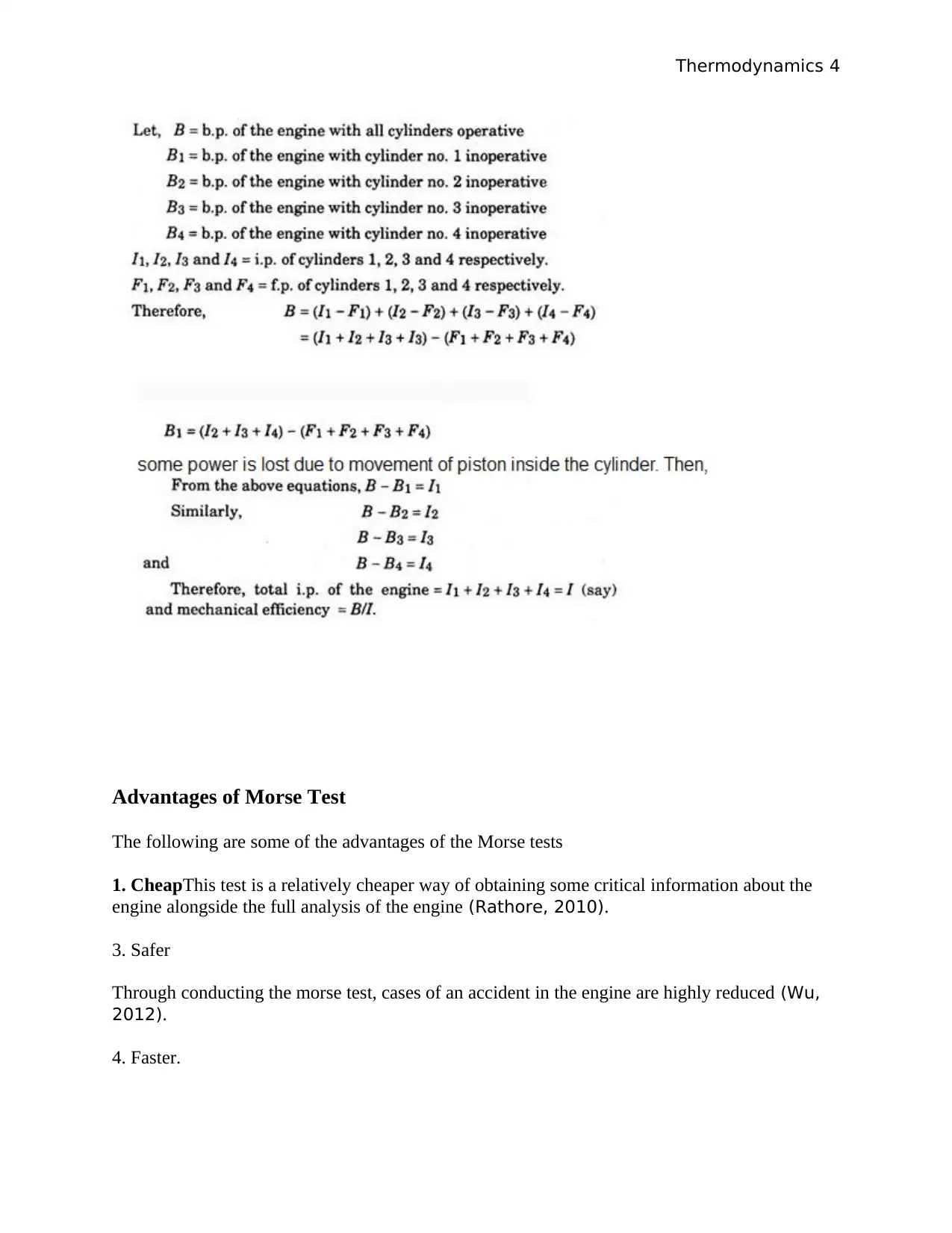
Thermodynamics 4
Advantages of Morse Test
The following are some of the advantages of the Morse tests
1. CheapThis test is a relatively cheaper way of obtaining some critical information about the
engine alongside the full analysis of the engine (Rathore, 2010).
3. Safer
Through conducting the morse test, cases of an accident in the engine are highly reduced (Wu,
2012).
4. Faster.
Advantages of Morse Test
The following are some of the advantages of the Morse tests
1. CheapThis test is a relatively cheaper way of obtaining some critical information about the
engine alongside the full analysis of the engine (Rathore, 2010).
3. Safer
Through conducting the morse test, cases of an accident in the engine are highly reduced (Wu,
2012).
4. Faster.
Paraphrase This Document
Need a fresh take? Get an instant paraphrase of this document with our AI Paraphraser
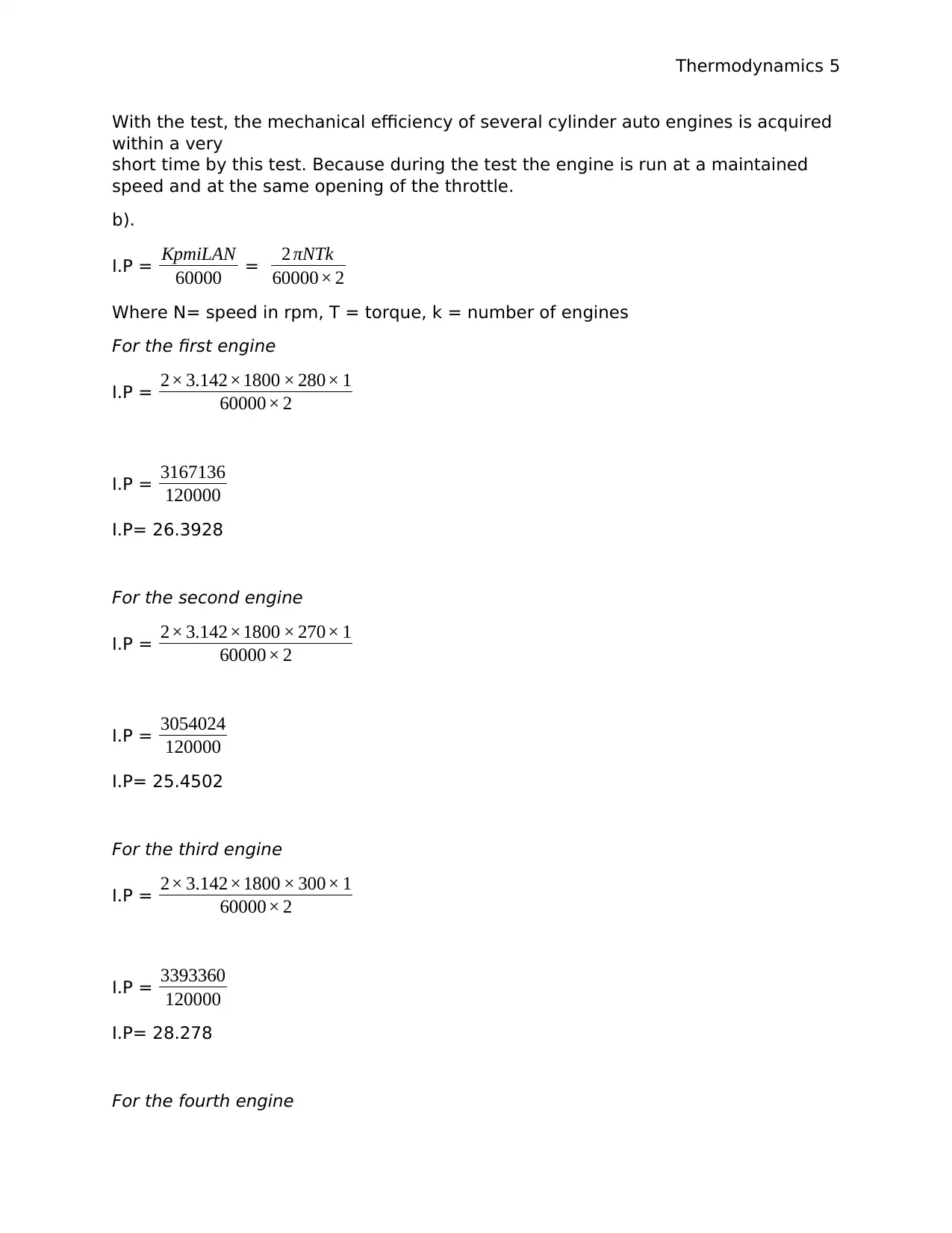
Thermodynamics 5
With the test, the mechanical efficiency of several cylinder auto engines is acquired
within a very
short time by this test. Because during the test the engine is run at a maintained
speed and at the same opening of the throttle.
b).
I.P = KpmiLAN
60000 = 2 πNTk
60000× 2
Where N= speed in rpm, T = torque, k = number of engines
For the first engine
I.P = 2× 3.142×1800 × 280× 1
60000× 2
I.P = 3167136
120000
I.P= 26.3928
For the second engine
I.P = 2× 3.142×1800 × 270× 1
60000× 2
I.P = 3054024
120000
I.P= 25.4502
For the third engine
I.P = 2× 3.142×1800 × 300× 1
60000× 2
I.P = 3393360
120000
I.P= 28.278
For the fourth engine
With the test, the mechanical efficiency of several cylinder auto engines is acquired
within a very
short time by this test. Because during the test the engine is run at a maintained
speed and at the same opening of the throttle.
b).
I.P = KpmiLAN
60000 = 2 πNTk
60000× 2
Where N= speed in rpm, T = torque, k = number of engines
For the first engine
I.P = 2× 3.142×1800 × 280× 1
60000× 2
I.P = 3167136
120000
I.P= 26.3928
For the second engine
I.P = 2× 3.142×1800 × 270× 1
60000× 2
I.P = 3054024
120000
I.P= 25.4502
For the third engine
I.P = 2× 3.142×1800 × 300× 1
60000× 2
I.P = 3393360
120000
I.P= 28.278
For the fourth engine
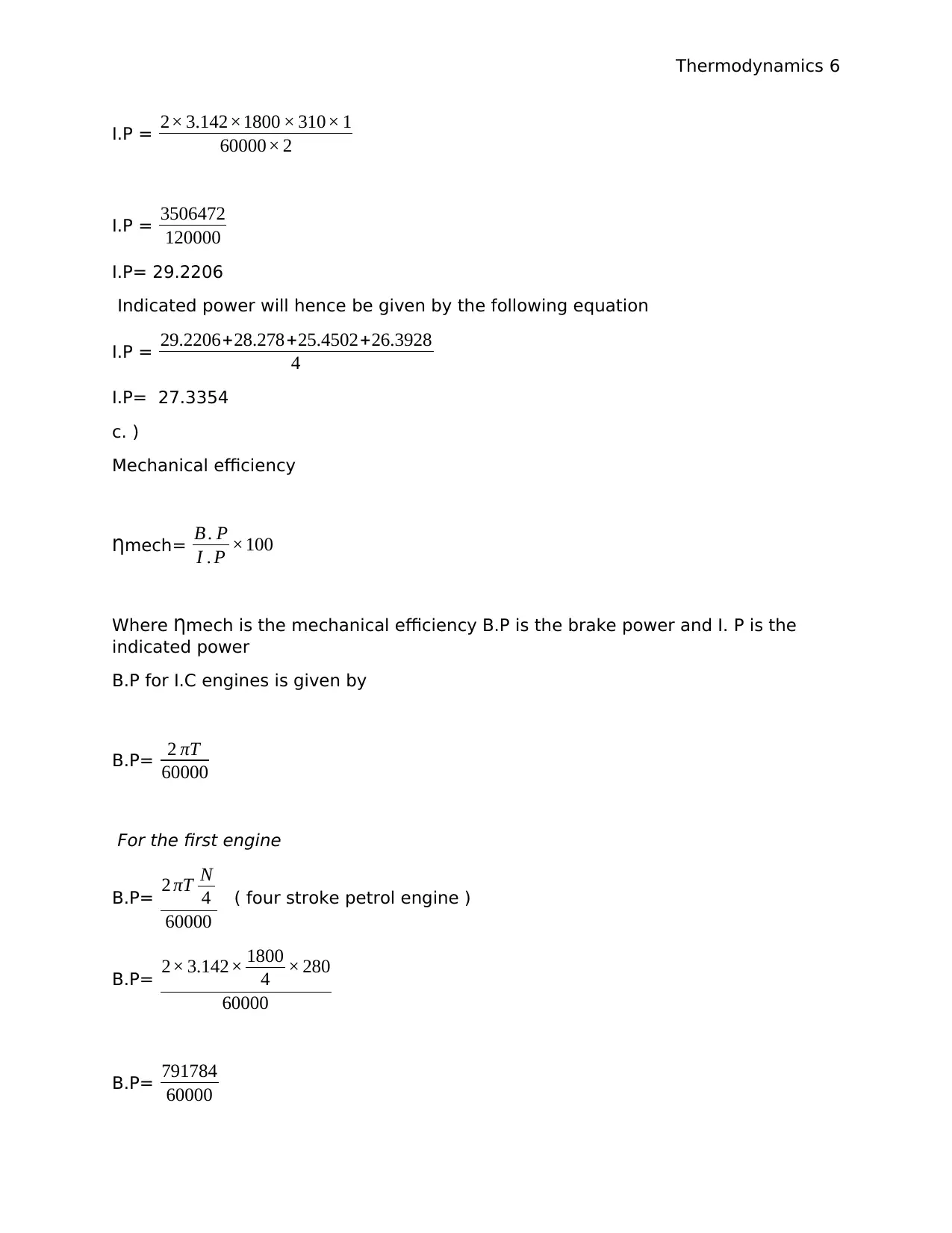
Thermodynamics 6
I.P = 2× 3.142×1800 × 310× 1
60000× 2
I.P = 3506472
120000
I.P= 29.2206
Indicated power will hence be given by the following equation
I.P = 29.2206+28.278+25.4502+26.3928
4
I.P= 27.3354
c. )
Mechanical efficiency
Ƞmech= B . P
I . P ×100
Where Ƞmech is the mechanical efficiency B.P is the brake power and I. P is the
indicated power
B.P for I.C engines is given by
B.P= 2 πT
60000
For the first engine
B.P= 2 πT N
4
60000
( four stroke petrol engine )
B.P= 2× 3.142× 1800
4 × 280
60000
B.P= 791784
60000
I.P = 2× 3.142×1800 × 310× 1
60000× 2
I.P = 3506472
120000
I.P= 29.2206
Indicated power will hence be given by the following equation
I.P = 29.2206+28.278+25.4502+26.3928
4
I.P= 27.3354
c. )
Mechanical efficiency
Ƞmech= B . P
I . P ×100
Where Ƞmech is the mechanical efficiency B.P is the brake power and I. P is the
indicated power
B.P for I.C engines is given by
B.P= 2 πT
60000
For the first engine
B.P= 2 πT N
4
60000
( four stroke petrol engine )
B.P= 2× 3.142× 1800
4 × 280
60000
B.P= 791784
60000
⊘ This is a preview!⊘
Do you want full access?
Subscribe today to unlock all pages.

Trusted by 1+ million students worldwide
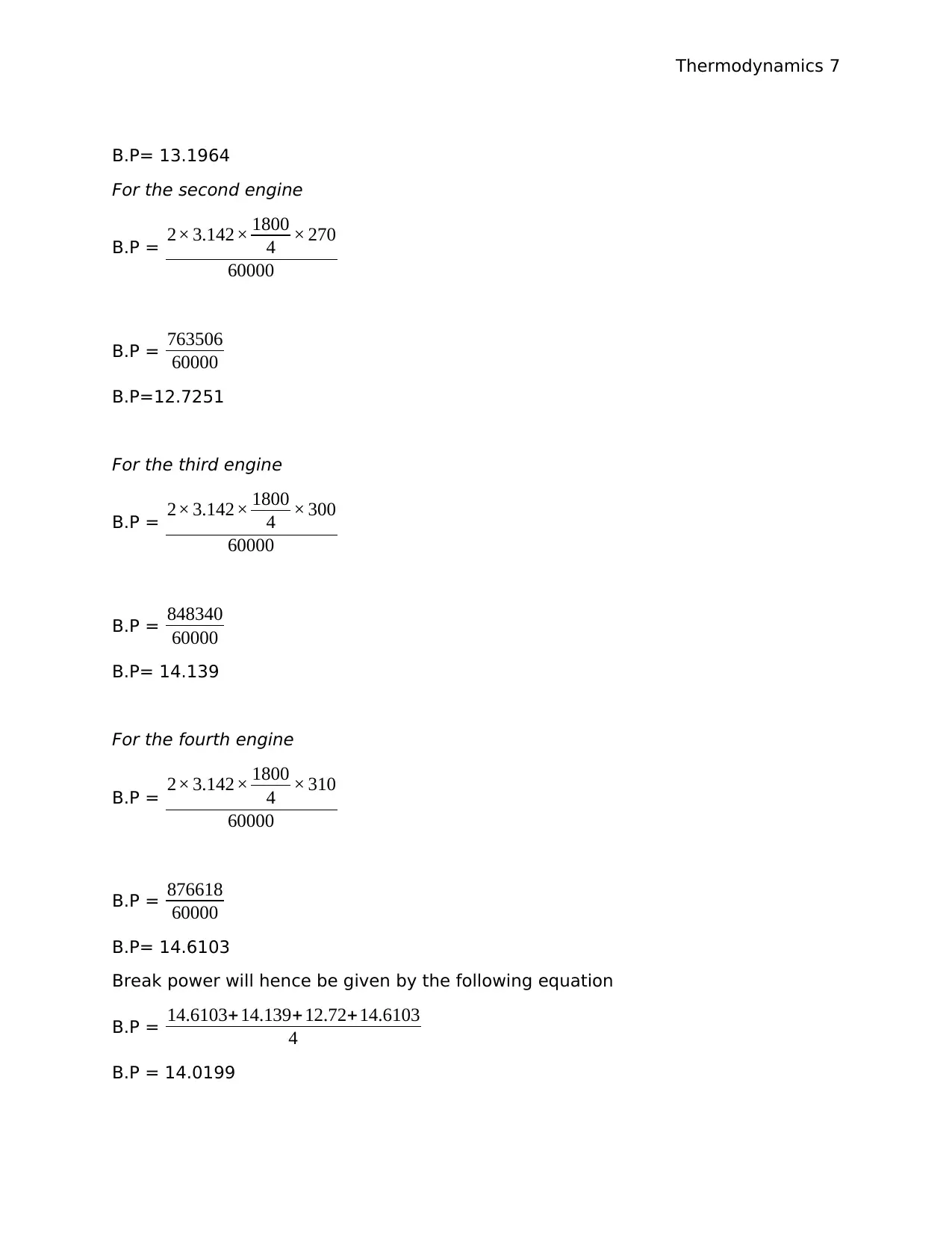
Thermodynamics 7
B.P= 13.1964
For the second engine
B.P = 2× 3.142× 1800
4 × 270
60000
B.P = 763506
60000
B.P=12.7251
For the third engine
B.P = 2× 3.142× 1800
4 × 300
60000
B.P = 848340
60000
B.P= 14.139
For the fourth engine
B.P = 2× 3.142× 1800
4 × 310
60000
B.P = 876618
60000
B.P= 14.6103
Break power will hence be given by the following equation
B.P = 14.6103+ 14.139+ 12.72+14.6103
4
B.P = 14.0199
B.P= 13.1964
For the second engine
B.P = 2× 3.142× 1800
4 × 270
60000
B.P = 763506
60000
B.P=12.7251
For the third engine
B.P = 2× 3.142× 1800
4 × 300
60000
B.P = 848340
60000
B.P= 14.139
For the fourth engine
B.P = 2× 3.142× 1800
4 × 310
60000
B.P = 876618
60000
B.P= 14.6103
Break power will hence be given by the following equation
B.P = 14.6103+ 14.139+ 12.72+14.6103
4
B.P = 14.0199
Paraphrase This Document
Need a fresh take? Get an instant paraphrase of this document with our AI Paraphraser

Thermodynamics 8
Ƞmech= B . P
I . P ×100
Ƞmech= 14.0199
27.3354 × 100
Ƞmech=0.51288×100
Ƞmech= 51.288 %
d). Break thermal efficiency
ȠBth= P . B× 3600
Mf × Cv ×100
Where B.P is the Break power, Mf is the mass of fuel consumed in mass/ unit time
( kg/h), Cv is the calorific value of the fuel
B.P = 14.0199
Mf=0.25kg/kWh × 75 kW = 18.75
Cv= 45 000
ȠBth= 14.0199× 3600
18.75 × 45000 ×100
ȠBth= 50 471.64
843750 × 100
ȠBth= 0.0598×100
ȠBth=5.981%
Question three
Ƞmech= B . P
I . P ×100
Ƞmech= 14.0199
27.3354 × 100
Ƞmech=0.51288×100
Ƞmech= 51.288 %
d). Break thermal efficiency
ȠBth= P . B× 3600
Mf × Cv ×100
Where B.P is the Break power, Mf is the mass of fuel consumed in mass/ unit time
( kg/h), Cv is the calorific value of the fuel
B.P = 14.0199
Mf=0.25kg/kWh × 75 kW = 18.75
Cv= 45 000
ȠBth= 14.0199× 3600
18.75 × 45000 ×100
ȠBth= 50 471.64
843750 × 100
ȠBth= 0.0598×100
ȠBth=5.981%
Question three
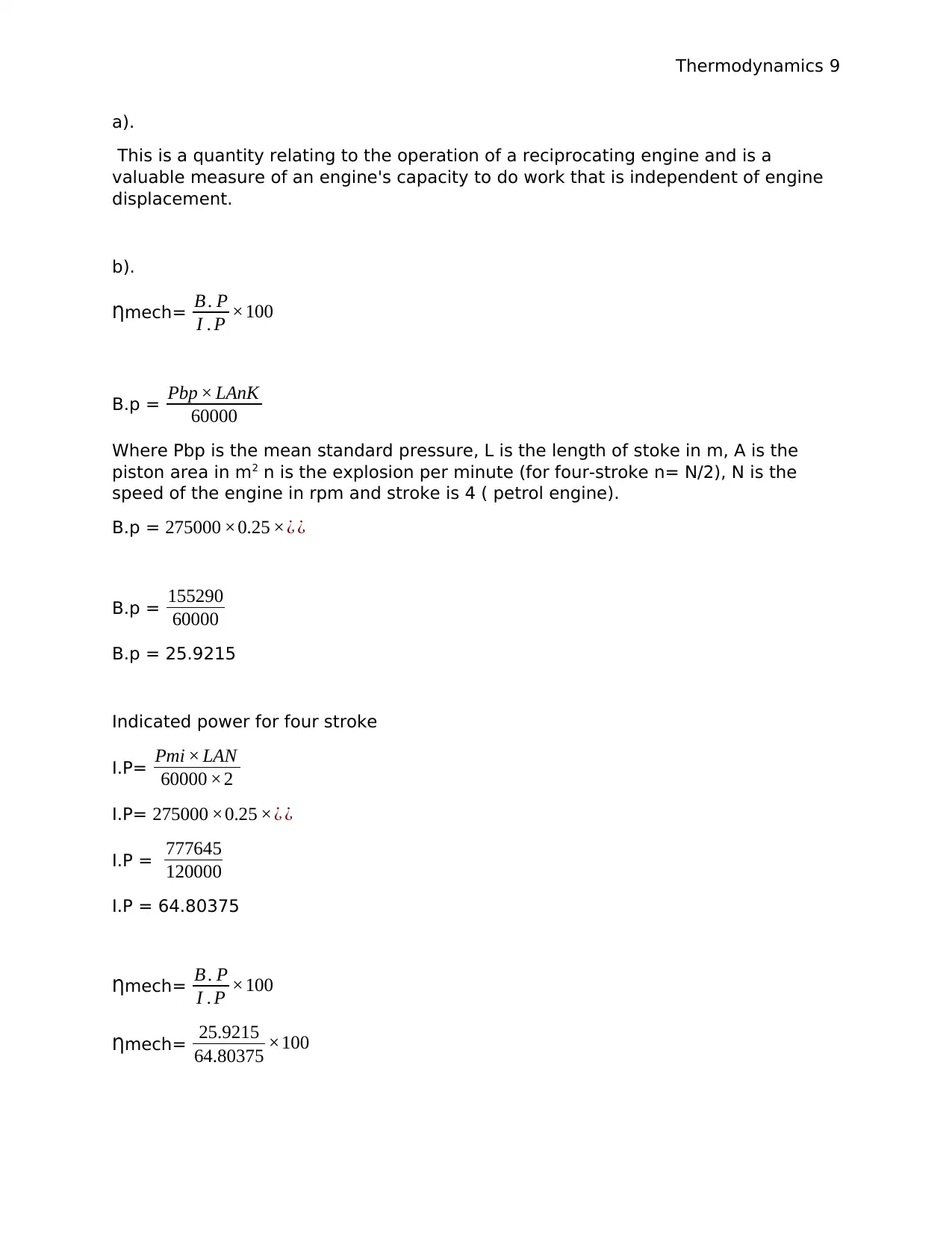
Thermodynamics 9
a).
This is a quantity relating to the operation of a reciprocating engine and is a
valuable measure of an engine's capacity to do work that is independent of engine
displacement.
b).
Ƞmech= B . P
I . P ×100
B.p = Pbp × LAnK
60000
Where Pbp is the mean standard pressure, L is the length of stoke in m, A is the
piston area in m2 n is the explosion per minute (for four-stroke n= N/2), N is the
speed of the engine in rpm and stroke is 4 ( petrol engine).
B.p = 275000 ×0.25 ׿ ¿
B.p = 155290
60000
B.p = 25.9215
Indicated power for four stroke
I.P= Pmi × LAN
60000 ×2
I.P= 275000 ×0.25 ׿ ¿
I.P = 777645
120000
I.P = 64.80375
Ƞmech= B . P
I . P ×100
Ƞmech= 25.9215
64.80375 ×100
a).
This is a quantity relating to the operation of a reciprocating engine and is a
valuable measure of an engine's capacity to do work that is independent of engine
displacement.
b).
Ƞmech= B . P
I . P ×100
B.p = Pbp × LAnK
60000
Where Pbp is the mean standard pressure, L is the length of stoke in m, A is the
piston area in m2 n is the explosion per minute (for four-stroke n= N/2), N is the
speed of the engine in rpm and stroke is 4 ( petrol engine).
B.p = 275000 ×0.25 ׿ ¿
B.p = 155290
60000
B.p = 25.9215
Indicated power for four stroke
I.P= Pmi × LAN
60000 ×2
I.P= 275000 ×0.25 ׿ ¿
I.P = 777645
120000
I.P = 64.80375
Ƞmech= B . P
I . P ×100
Ƞmech= 25.9215
64.80375 ×100
⊘ This is a preview!⊘
Do you want full access?
Subscribe today to unlock all pages.

Trusted by 1+ million students worldwide
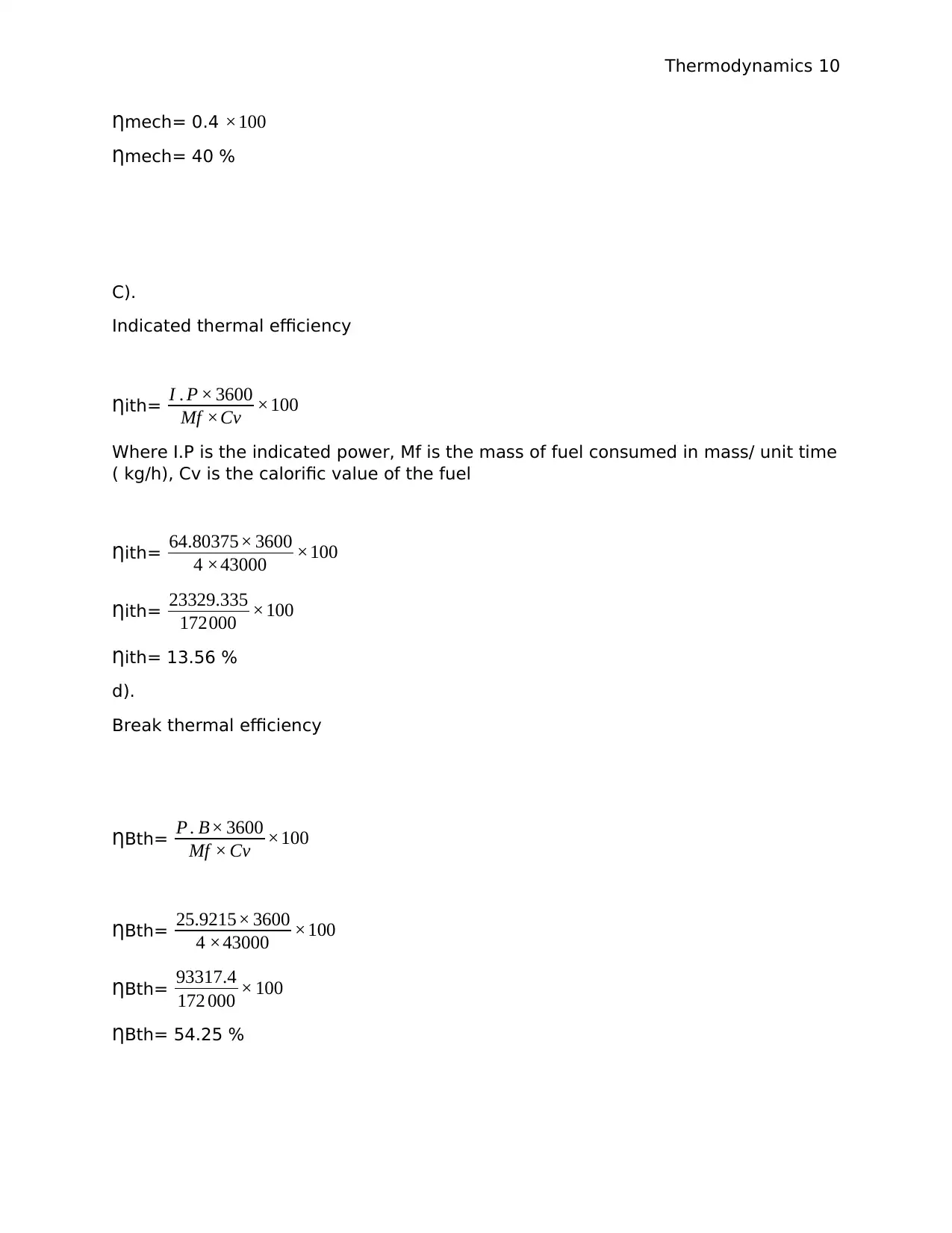
Thermodynamics 10
Ƞmech= 0.4 ×100
Ƞmech= 40 %
C).
Indicated thermal efficiency
Ƞith= I . P × 3600
Mf ×Cv ×100
Where I.P is the indicated power, Mf is the mass of fuel consumed in mass/ unit time
( kg/h), Cv is the calorific value of the fuel
Ƞith= 64.80375× 3600
4 ×43000 ×100
Ƞith= 23329.335
172000 ×100
Ƞith= 13.56 %
d).
Break thermal efficiency
ȠBth= P . B× 3600
Mf × Cv ×100
ȠBth= 25.9215× 3600
4 ×43000 ×100
ȠBth= 93317.4
172 000 × 100
ȠBth= 54.25 %
Ƞmech= 0.4 ×100
Ƞmech= 40 %
C).
Indicated thermal efficiency
Ƞith= I . P × 3600
Mf ×Cv ×100
Where I.P is the indicated power, Mf is the mass of fuel consumed in mass/ unit time
( kg/h), Cv is the calorific value of the fuel
Ƞith= 64.80375× 3600
4 ×43000 ×100
Ƞith= 23329.335
172000 ×100
Ƞith= 13.56 %
d).
Break thermal efficiency
ȠBth= P . B× 3600
Mf × Cv ×100
ȠBth= 25.9215× 3600
4 ×43000 ×100
ȠBth= 93317.4
172 000 × 100
ȠBth= 54.25 %
Paraphrase This Document
Need a fresh take? Get an instant paraphrase of this document with our AI Paraphraser
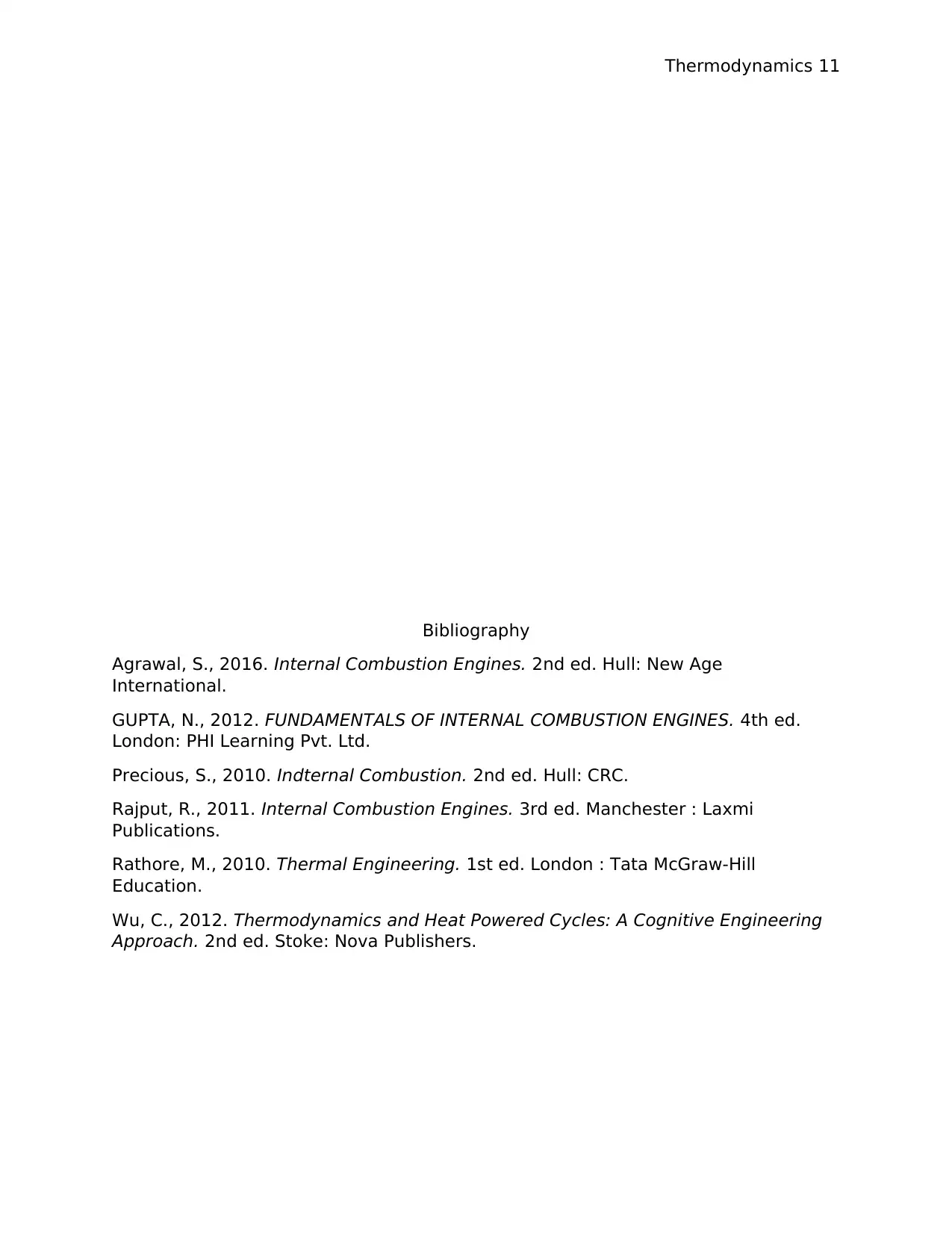
Thermodynamics 11
Bibliography
Agrawal, S., 2016. Internal Combustion Engines. 2nd ed. Hull: New Age
International.
GUPTA, N., 2012. FUNDAMENTALS OF INTERNAL COMBUSTION ENGINES. 4th ed.
London: PHI Learning Pvt. Ltd.
Precious, S., 2010. Indternal Combustion. 2nd ed. Hull: CRC.
Rajput, R., 2011. Internal Combustion Engines. 3rd ed. Manchester : Laxmi
Publications.
Rathore, M., 2010. Thermal Engineering. 1st ed. London : Tata McGraw-Hill
Education.
Wu, C., 2012. Thermodynamics and Heat Powered Cycles: A Cognitive Engineering
Approach. 2nd ed. Stoke: Nova Publishers.
Bibliography
Agrawal, S., 2016. Internal Combustion Engines. 2nd ed. Hull: New Age
International.
GUPTA, N., 2012. FUNDAMENTALS OF INTERNAL COMBUSTION ENGINES. 4th ed.
London: PHI Learning Pvt. Ltd.
Precious, S., 2010. Indternal Combustion. 2nd ed. Hull: CRC.
Rajput, R., 2011. Internal Combustion Engines. 3rd ed. Manchester : Laxmi
Publications.
Rathore, M., 2010. Thermal Engineering. 1st ed. London : Tata McGraw-Hill
Education.
Wu, C., 2012. Thermodynamics and Heat Powered Cycles: A Cognitive Engineering
Approach. 2nd ed. Stoke: Nova Publishers.
1 out of 11
Your All-in-One AI-Powered Toolkit for Academic Success.
+13062052269
info@desklib.com
Available 24*7 on WhatsApp / Email
![[object Object]](/_next/static/media/star-bottom.7253800d.svg)
Unlock your academic potential
Copyright © 2020–2025 A2Z Services. All Rights Reserved. Developed and managed by ZUCOL.